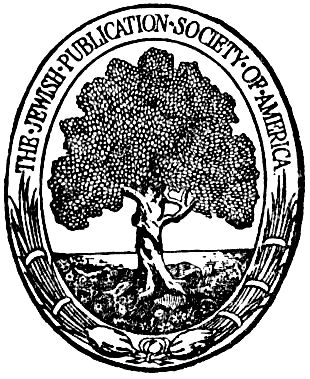Transcriber’s Note:
The cover image was created by the transcriber and is placed in the public domain.
POST-BIBLICAL HEBREW LITERATURE
AN ANTHOLOGY

PREFACE
Although the Hebrew language ceased to be thevernacular of the majority of the Jewish people duringthe last years of the second temple, it has, throughoutthe various periods, with but few exceptions,persisted as the medium for the noblest literary productionsof the nation. Irrespective of the languagespoken by the people in the countries of their adoption,the best thoughts of the Jewish writers found expressionin the holy tongue. The Gemara, which ispreponderately in Aramaic, can hardly be regarded asan exception, for it consists, in the main, of records oforal discussions and arguments, which were naturallycarried on in the vernacular, and as such it is not tobe classed among works of literature in its narrowersense. On the other hand, it is very significant thatthe Midrash and some of the midrashic elements inthe Talmud are mostly in Hebrew, and it is just theseparts which may claim to be regarded as literature.Then the prayers, many of which date from the earlycenturies of the present era, and the piyyutim arepractically all in Hebrew.
When the centre of Jewish literary activity wastransferred to Arabic-speaking countries, the Hebrewlanguage still continued to be employed by a goodmany of the writers. The treatises with a practicalpurpose, intended for the edification of the people atlarge, were, it is true, written in the vernacular, butthe literary productions were composed in Hebrew.Lexicographical, grammatical, and philosophical books6appealed to the general public, and had therefore tobe expressed in the language spoken by the people.But Hebrew was employed for the literary compositions,poems, and piyyutim. Sa’adya, Ibn Gebirol,and Judah ha-Levi wrote their philosophic works,which undoubtedly had a didactic aim, in Arabic, buttheir poems and hymns are invariably in Hebrew.Moreover, the popularity of books written in Arabicwas short-lived. For shortly afterwards the centreof Jewish learning was shifted to other countries,and the vast Jewish-Arabic literature inevitably becamea sealed book. While the Hebrew translations ofSa’adya’s Faiths and Creeds, Bahya’s Duties of theHeart, Judah ha-Levi’s Khazarite, and Maimonides’Guide of the Perplexed have been repeatedly printed,the Arabic originals of these books had been mouldingin the various libraries until scholars in comparativelyrecent years unearthed them and published themfor the